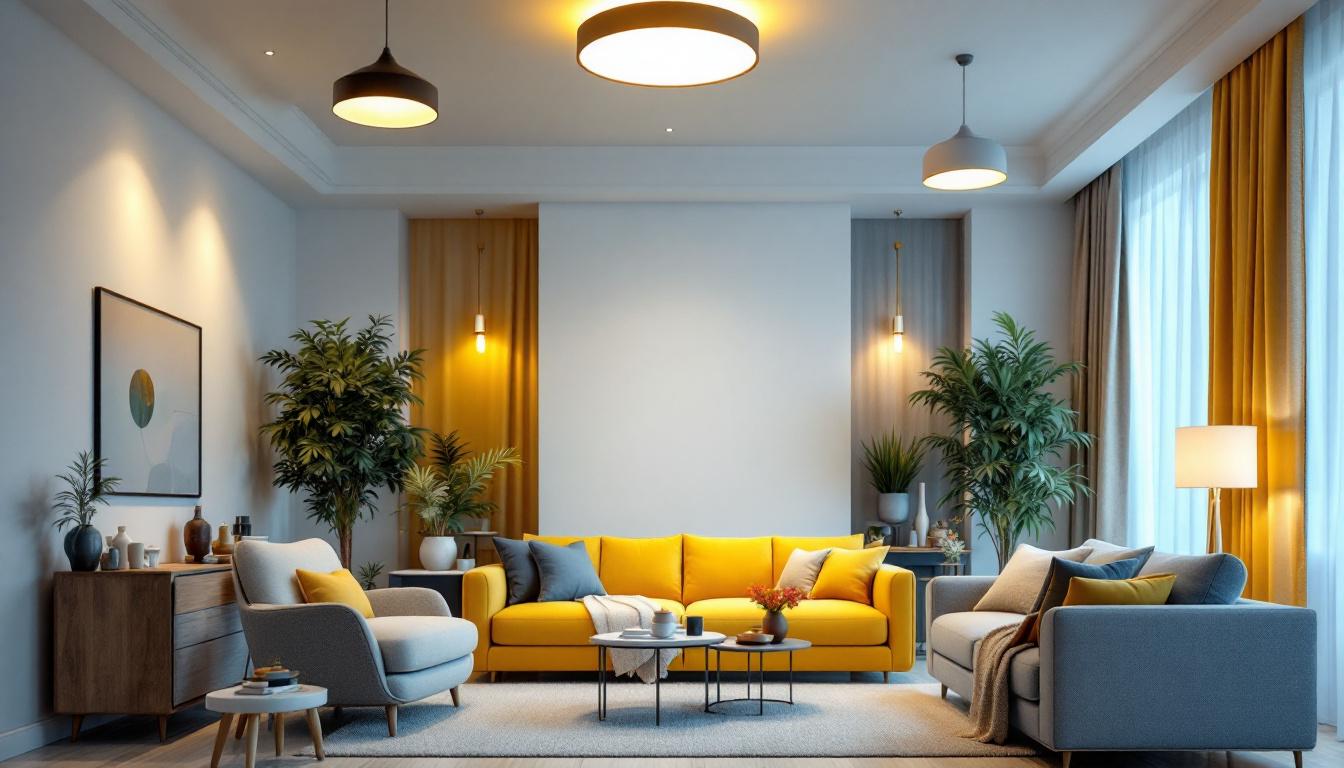
When it comes to lighting projects, particularly in living rooms, the choice of ceiling lights can significantly influence the overall ambiance and functionality of the space. Lighting contractors must navigate a myriad of options, styles, and technical considerations to ensure that their projects not only meet aesthetic expectations but also adhere to practical requirements. This article delves into common pitfalls in lighting design and offers insights on how to avoid them, ensuring a successful outcome for both contractors and clients.
Ceiling lights serve as the primary source of illumination in a living room, setting the tone for the entire space. They can enhance architectural features, create focal points, and provide necessary lighting for various activities. However, the wrong choice can lead to an uninviting atmosphere or inadequate lighting, which can be frustrating for clients.
Moreover, the living room is often the heart of the home, where families gather and entertain guests. Therefore, the lighting must be both functional and aesthetically pleasing. Understanding the role of ceiling lights in this context is crucial for contractors aiming to deliver exceptional results. The right lighting can also influence mood and productivity, making it essential to choose fixtures that complement the overall design while meeting the practical needs of the household.
In addition to functionality, ceiling lighting can be a reflection of personal style. From modern minimalist designs to ornate vintage fixtures, the choice of lighting can express the homeowner’s taste and enhance the overall decor. Thoughtfully selected ceiling lights can create a cohesive look that ties together various elements in the room, contributing to a harmonious atmosphere that feels inviting and warm.
There are several types of ceiling lights to consider, each with its unique characteristics and applications. Common options include flush mounts, chandeliers, pendant lights, and recessed lighting. Each type serves different purposes and can dramatically alter the room’s look and feel.
For instance, flush mounts provide a sleek, unobtrusive option for lower ceilings, while chandeliers can add a touch of elegance and sophistication. Pendant lights, on the other hand, can serve as statement pieces, drawing attention and creating visual interest. Understanding these options allows contractors to recommend the best solutions based on the client’s needs and preferences. Additionally, incorporating dimmable fixtures can offer versatility, allowing homeowners to adjust the brightness according to the time of day or the activity taking place, whether it’s a cozy movie night or a lively gathering.
Another popular choice is track lighting, which offers flexibility in directing light where it’s needed most. This type of lighting can be particularly useful in larger living rooms or spaces with multiple functions, as it allows for customizable illumination that can highlight artwork, architectural features, or specific areas of the room. By exploring all available options, contractors can ensure that clients are equipped with the best lighting solutions tailored to their unique spaces.
Before selecting ceiling lights, it is essential to assess the living room space thoroughly. Factors such as room size, ceiling height, and existing architectural elements play a crucial role in determining the appropriate lighting solution. A well-lit room should have a balance of ambient, task, and accent lighting, which can be achieved through a combination of different ceiling light types.
Additionally, considering the room’s layout and the placement of furniture can help in designing a lighting plan that enhances functionality and aesthetics. For example, a large sectional sofa may require additional lighting to ensure that all areas are adequately illuminated, while a smaller space may benefit from a single, well-placed fixture. Furthermore, the color scheme of the room can also influence lighting choices; lighter colors tend to reflect light better, while darker hues may require more powerful fixtures to achieve the desired brightness.
It’s also important to take into account the natural light available in the space. Windows and their orientation can greatly affect how much light enters the room throughout the day. By observing how the light shifts from morning to evening, contractors can recommend ceiling lights that complement the natural light, enhancing the overall ambiance and ensuring that the living room remains bright and inviting at all times. This holistic approach to lighting design not only improves the functionality of the space but also elevates the living experience for the homeowners.
Even seasoned lighting contractors can make mistakes that lead to costly revisions and dissatisfied clients. Here are some common pitfalls to avoid in ceiling lighting projects:
One of the most significant mistakes is failing to consider the scale of the ceiling lights in relation to the room. A large chandelier in a small living room can overwhelm the space, while a tiny flush mount in a grand room can feel insignificant. Proper scaling ensures that the lighting complements the room’s proportions and enhances its overall design.
To achieve the right scale, contractors should measure the room dimensions and consider the height of the ceiling. As a general rule, the diameter of a chandelier should be about one-half to two-thirds the width of the table it hangs above. This principle can also be applied to other types of fixtures to create a harmonious look.
Effective lighting design involves layering different types of lighting to create a well-rounded atmosphere. Relying solely on ceiling lights can lead to harsh shadows and an uninviting environment. Instead, incorporating ambient, task, and accent lighting can elevate the overall experience.
Ambient lighting provides general illumination, while task lighting focuses on specific areas for activities such as reading or working. Accent lighting, on the other hand, highlights architectural features or artwork. By combining these layers, contractors can create a dynamic and versatile lighting scheme that caters to various needs and moods.
In today’s environmentally conscious world, energy efficiency is more important than ever. Choosing the right type of bulbs and fixtures can significantly impact energy consumption and operating costs. LED lights, for example, offer a longer lifespan and lower energy usage compared to traditional incandescent bulbs.
Contractors should educate clients about the benefits of energy-efficient lighting options and help them make informed decisions. Additionally, incorporating smart lighting solutions, such as dimmers and timers, can further enhance energy savings while providing flexibility in lighting control.
Designing a lighting plan goes beyond simply choosing fixtures. Several design considerations can enhance the effectiveness and appeal of ceiling lights in a living room setting.
The finish and style of ceiling lights should complement the overall design theme of the living room. Whether the space is modern, traditional, or eclectic, the chosen fixtures should blend seamlessly with the decor. For instance, a sleek chrome finish may suit a contemporary space, while an antique brass fixture could enhance a vintage aesthetic.
Contractors should also consider the shape and design of the fixtures. Geometric shapes can add a modern touch, while ornate designs may evoke a sense of classic elegance. Selecting the right style not only enhances the visual appeal but also reinforces the intended atmosphere of the room.
Dimmer switches are a valuable addition to any lighting project, allowing for greater control over the ambiance. By adjusting the brightness of ceiling lights, clients can create different moods for various occasions, from bright and lively gatherings to cozy, intimate evenings.
Incorporating dimmers into the design also contributes to energy efficiency, as they enable users to reduce energy consumption when full brightness is not needed. Educating clients about the benefits of dimmer switches can enhance their overall satisfaction with the lighting design.
As technology continues to evolve, integrating smart lighting solutions into ceiling light designs has become increasingly popular. These systems offer convenience, efficiency, and customization that can greatly enhance the user experience.
Smart lighting systems allow users to control their ceiling lights remotely through smartphones or voice-activated devices. This technology enables homeowners to adjust brightness, set schedules, and even change colors to suit their preferences. Incorporating smart solutions into lighting projects can set contractors apart from competitors and meet the growing demand for modern conveniences.
Moreover, these systems often come with energy monitoring features, allowing users to track their energy usage and make adjustments to reduce costs. Educating clients about the benefits of smart lighting can lead to more informed decisions and increased satisfaction with the final outcome.
As technology continues to advance, it is essential for contractors to consider future-proofing their lighting designs. This involves selecting fixtures and systems that can adapt to emerging technologies and changing preferences.
For example, choosing fixtures that are compatible with various smart home systems ensures that clients can easily upgrade their lighting as new technologies become available. Additionally, opting for flexible designs that can accommodate changes in decor or functionality will keep the living room relevant and appealing for years to come.
Ceiling lights play a crucial role in the overall design and functionality of living rooms. By understanding the importance of scale, layering lighting, and avoiding common mistakes, contractors can create stunning and effective lighting solutions that meet clients’ needs.
Furthermore, considering design elements such as style, finishes, and technology integration can elevate the overall experience and satisfaction of homeowners. By staying informed about the latest trends and innovations in lighting design, contractors can ensure that their projects are not only visually appealing but also practical and efficient.
Ultimately, successful lighting projects require careful planning, attention to detail, and a deep understanding of the client’s vision. By avoiding costly mistakes and embracing innovative solutions, lighting contractors can deliver exceptional results that enhance the beauty and functionality of living rooms.
Ready to elevate your lighting projects with the perfect balance of style, efficiency, and value? Look no further than LumenWholesale for all your ceiling lighting needs. We provide contractors with an unbeatable selection of spec-grade lighting products at wholesale prices, ensuring you can deliver exceptional living room lighting designs without the burden of inflated costs. With free shipping on bulk orders, you can trust that you’re getting premium lighting solutions at the best value. Don’t compromise on quality or affordability. Visit LumenWholesale today and experience the ease of sourcing top-tier lighting for your next project.

Discover why staying updated on the latest trends and technologies in apartment lighting is crucial for every lighting contractor.

Discover how fluorescent lighting can be a game-changer for lighting contractors looking to secure more bids.

Discover essential insights and practical tips in “Light Posts: A Guide for Lighting Contractors.” This comprehensive guide covers everything from selecting the right materials to installation techniques, ensuring your projects shine brightly and efficiently.

Discover how solar outdoor wall lights are revolutionizing the lighting industry, offering eco-friendly solutions that enhance efficiency and creativity for contractors.